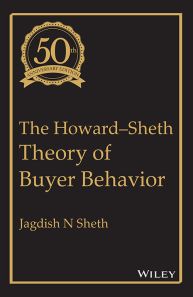The Howard-Sheth Theory of Buyer Behavior
ISBN: 9788126555024
528 pages
For more information write to us at: acadmktg@wiley.com

Description
The Howard-Sheth Theory of Buyer Behavior (1969) is recognized as a major catalyst for the rise of consumer behavior as a standalone discipline and independent of market research. In the last 50 years, consumer behavior has experienced spectacular growth especially with the influence of behavioral sciences. The next 50 years will be even more exciting. Stay tuned. The key drivers are the rise of emerging markets such as China and India as the largest consumer markets in the world for branded products and services.
Dedication
Tributes
Foreword
Preface
Acknowledgments
Prologue
Part I The Nature of The Theory and A Summary
Chapter 1 Theory: Function, Need, and Structure
1.1 Functions of Theory
1.2 The Problem of Buyer Behavior
1.3 Structure of Theory
1.4 Summary and Conclusions
Chapter 2 Summary of the Theory of Buyer Behavior
2.1 Buying Process
2.2 Description of Constructs
2.3 Relationships among Hypothetical Constructs
2.4 Summary and Conclusions
Part II Structure of The Theory
Chapter 3 Intervening and Exogenous Variables
3.1 Classification of Variables
3.2 Output Variables
3.3 Input Variables
3.4 Exogenous Variables
3.5 Summary
Chapter 4 Learning Subsystem
4.1 Brand Comprehension
4.2 Motives
4.3 Choice Criteria
4.4 Attitude
4.5 Intention (To Buy)
4.6 Confidence (In Choice)
4.7 Satisfaction
4.8 Purchase Decision
4.9 Summary of Learning Constructs
Chapter 5 Perceptual Constructs
5.1 Influences on Quantity of Information
5.2 Perceptual Bias
5.3 Summary and Conclusions
5.4 Hypothetical Constructs and Intervening Variables
5.5 Theory of Search
5.6 Routinized Response Behavior
Part III The Theory and Its Measurement
Chapter 6 Attitude’ as an Intervening Variable
6.1 Rules of Correspondence
6.2 Measurement and Scaling
6.1 A Multivariate Approach to Attitude¢ Measurement
6.3 Dynamics of Attitude Change
6.4 Summary and Conclusions
Chapter 7 Purchase Behavior and Brand Loyalty
7.1 Purchase as an Intervening Variable
7.2 Stochastic Approaches to Brand Loyalty
7.3 Factor-Analytic Methods of Measuring Brand Loyalty
7.4 Summary and Conclusions
Part IV The Theory and Its Application
Chapter 8 Product Innovation
8.1 Product Class
8.2 Search Behavior
8.3 Sources of Information
8.4 Exogenous Variables
8.5 Summary
Chapter 9 Symbolic Communication
9.1 Significative versus Symbolic Communication
9.2 A Paradigm of Symbolic Communication
9.3 Source of Communication
9.4 Channels of Communication
9.5 Message and Its Effects on Response Sequence
9.6 Summary and Conclusions
Part V Summary and Implications
Chapter 10 Theory: Structure, Function, and Need
10.1 Introduction
10.2 Functions of the Theory
10.3 Need for the Theory
10.4 Summary of Relations among Structure, Function, and Need
Glossary of Terms
Bibliography
Index

